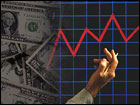|
Life-cycle funds: blessing or curse?
|
 |
January 11, 2002: 11:25 a.m. ET
Retirement investing left to others may cause relief - or create more stress.
By Annelena Lobb
|
NEW YORK (CNN/Money) - There's a mutual fund for every investor, something for every taste. But if you're investing for the first time, nervous about where your precious retirement dollars belong, or you don't know how much risk you can tolerate, the overwhelming number of options may seem like more of a curse than a blessing.
That's where life-cycle funds enter the picture. Designed for one-stop investment shopping, life-cycle funds distribute your money among various other funds, changing your asset allocation -- i.e., which funds you use and how much goes to each -- as you enter different life stages. Fund families like Vanguard, Charles Schwab, T. Rowe Price and Fidelity all offer life-cycle funds.
The idea behind life-cycle funds, roughly, is first to grow and expand your assets, then to preserve them as your retirement date nears -- in other words, by putting all your eggs in one changing basket.
"In effect, the life-cycle fund is an investment choice for a lifetime," said Lisa Boucher, a vice-president in Fidelity Investments' Employer Service Group. "People may not have the skill set they need to change their allocation as retirement nears. These funds provide a simple but very sophisticated solution."
How they work
Many life-cycle funds work in series. Individuals invest in one life-cycle fund at a time and shift to a different fund in the series as their needs change.
If you began with Vanguard Life Strategy Growth Fund, for example, your money would be heavily invested in funds like Vanguard's Total Stock Market Index Fund and Total International Stock Index Fund. But if you wanted something less risky as you approached retirement, you could then shift your assets to the Vanguard Life Strategy Conservative Growth Fund, for example, which reduces the amount it invests in more volatile Vanguard funds and focuses on more conservative investments, like Vanguard Total Bond Market Index Fund.
"Target-retirement funds" are another type of life-cycle fund -- they do the switching for you. If it's a fund designed for those hoping to retire in 2030, for example, the manager will do the job of moving the fund's assets from more aggressive to more conservative investments over the next 28 years.
Fidelity's Freedom Funds are popular examples. Since the creation of Fidelity Freedom 2020 in 1996, its asset makeup has changed. If you socked away your retirement assets there in 1996, and planned to retire in or around 2020, the idea is that the changes in this fund's asset mix would suit your goal perfectly.
In Nov. 1996, the fund held 82.6 percent of its assets in a stable of Fidelity equity funds and 17.1 percent in fixed-income funds. But about 12 percent of the amount it originally held in equity funds has since been moved to fixed income -- the equity portion of the portfolio now stands at 70.5 percent, while the fixed income portion has increased to 29.2 percent.
Are they for you?
In their aim to simplify retirement investing, however, life-cycle funds do create some problems. Although novices may be jittery about making mistakes when investing their retirement money, the idea of turning over the reins to someone else -- almost entirely -- may not be too pleasant either.
"These funds may be good for someone investing a limited amount of money who wants diversification," said Scott M. Kahan, a CFP and president of Financial Asset Management in New York, NY. "But I think it's best if the investor maintains control of asset allocation."
You'll also have to consider the expenses on these funds -- the average life-cycle fund's expense ratio is 1.12 percent, according to Morningstar. A fund like Fidelity Freedom 2020, for example, has an expense ratio of .85 percent, calculated by taking a weighted average of all the expense ratios of the funds within it plus a .08 percent management fee.
Besides the issues of expenses and control, there's the question of whether you invest retirement money in other funds or stocks as well. According to Fidelity, 80 percent of the people who use their Freedom funds through an employer-sponsored retirement plan use them the way they were intended -- i.e., no money invested anywhere else, except company stock.
The other 20 percent, who have money in other assets, may not feel comfortable putting all their eggs in one basket, even if it spreads their assets around. Understandable, but it begs the question of whether they've missed the point of the life-cycle fund -- simplicity. 
|
|
|
|
|
|

|

